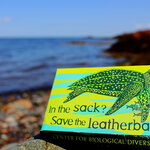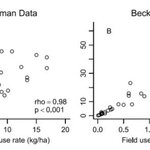Environment

U.S. farmers have long hoped to extend sugarcane's growing range northward from the Gulf coast because it substantially increase the land available for sugar and (for as long as subsidies last) biofuels.
Several hybrid canes developed in the 1980s have proved hardy in cooler climes, surviving overwinter as far north as Booneville, Arkansas, but no one had tested whether
the offspring of crosses between sugarcane and a hardy, cold-tolerant grass, Miscanthus - "miscanes" - actually photosynthesize, and thus continue to grow, when the thermometer dips.
Researchers now report that two miscanes…

Scientists analyzing the latest data from Comet 67P Churyumov-Gerasimenko have discovered molecules that can form sugars and amino acids, which are the building blocks of life as we know it. While this is a long, long way from finding life itself, the data shows that the organic compounds that eventually translated into organisms here on Earth existed in the early solar system.
The results are published as two independent papers in the journal Science, based on data from two different instruments on comet lander Philae. One comes from the German-led Cometary Sampling and Composition (COSAC)…

Perhaps the most effective way to scare consumers and regulatory agencies alike is to suggest that a certain product contains a ‘dangerous’ chemical. Even more effective? Have a scientist with four degrees from MIT — but none in food science or genetics — publish a study concluding that the food we eat every day contains formaldehyde.
Nobody wants to ingest harmful substances let alone feed them to our family, so the idea of an embalming fluid finding its way to our dinner plates sounds horrific. But that’s exactly what Dr. V.A. Shiva Ayyadurai claims.
Ayyadurai…

On April 20, 2010, BP's Deepwater Horizon (DWH) drilling rig experienced a failure resulting in the discharge of gas and light sweet crude oil from a depth of approximately 5,000 feet.
Discharge continued for 87 days until July 15, 2010, five years ago this week, when the well was capped and the leak was contained.
The Gulf of Mexico Research Initiative GoMRI, a large-scale, coordinated research endeavor, was created in response to the disaster to improve society’s ability to understand the impacts of the oil on the ecosystem, learn new ways to mitigate oil in the environment, and understand…

Conservationists tend to spend their time worrying about protecting forests, catching poachers or keeping carbon out of the atmosphere. But all these things (and more) are driven by humans. Given that it’s easier and cheaper to reduce the human birth rate than it is to address these other issues, why aren’t conservationists more concerned about keeping our population down?
After all, it is estimated that more than three-quarters of the world’s ice-free land has been modified by people. We are already overstepping the planet’s boundaries and our actions are causing climate change and the sixth…

Like the fictional parents in the edgy comedy show South Park who blame Canada for all of their woes, environmentalists often coalesce around an issue and then come up with a simple but sometimes simplistic narrative to anchor their advocacy.
We've seen that with natural gas from hydraulic fracturing (fracking), which is often blamed for massive groundwater pollution (the EPA has rejected that claim) and methane gas release (rejected by numerous independent researchers). The decades long decline in the global frog population is often blamed on atrazine, although the decline is…

I’ve always been interested in how changes in agricultural production practices impact the environment. In particular, I’ve followed the adoption of genetically modified (GM) crops since I was an undergraduate, and try to stay up to date on research relating to the environmental impact associated with these crops.
Several publications over the last decade have relied on the environmental impact quotient (EIQ) to quantify the environmental impact of changes in pesticide use resulting from GM crops. The EIQ originated with a research group from Cornell (Kovach et al.) with a goal of…

Though pesticides are getting all of the attention from environmental groups when it comes to concern about bees, the science community instead knows it is mites and climate - were it as simple as pesticides, places like Australia and the United States, where the neonicotinoids often blamed by activists are common, would show losses, but instead they were limited to one section of Europe.
Instead, the most comprehensive study ever conducted of the impacts of climate change on critical pollinators finds that it's changing habitat and climate likely to blame. Of course, there is no way to…

One of the questions raised by the prospect of climate change is whether it could cause more species of animals to interbreed. Two species of flying squirrel have already produced mixed offspring and those have somehow been blamed on climate change, along with a hybrid polar bear and grizzly bear cub (known as a grolar bear, or a pizzly).
A paper in Nature Climate Change tallies the potential number of such pairings and across North and South America it estimates that only about 6 percent of closely related species whose ranges do not currently overlap are likely to come into contact by…

Researchers at the University of Georgia have a message for Southern tree farmers worried about unexplainable pine tree deaths: Don't panic.
A new study published in Forest Ecology and Management analyzed growth in thousands of pine tree plots across the Southeast and indicates that "southern pine decline" isn't happening on a large scale.
Some earlier reports and studies had hinted at large-scale deaths of pine trees from unexplained reasons. But looking at the hard data shows that this is not the case, said Kamal Gandhi, an associate professor and forest health expert at UGA's Warnell…